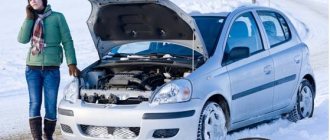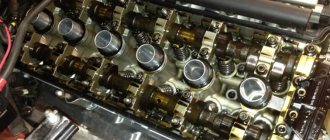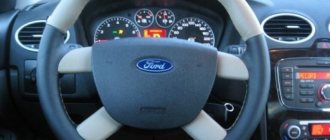The car is an important part of the daily lives of millions of people. But the machine requires proper care, since sometimes breakdowns and malfunctions occur. All of them are to a certain extent related to the characteristics of operation, or to the not very high quality of the spare parts used. If we talk about headlights, they are designed to ensure safe movement by car in the dark and in bad weather conditions. That's why they need special care. It consists of timely replacement of lamps, repair of faults and maintaining the required level of transparency of the glass or plastic case.
How to deal with fogging car headlights.
The driver does not always pay attention to a problem such as fogging in time. But ignoring this situation can lead to serious consequences. The resulting condensation turns into water droplets. Moisture contributes to the development of dangerous situations, which can result in extremely expensive repairs. Therefore, you should figure out what to do if the headlight sweats. The sooner you take on the problem, the better.
Reasons and what to do when headlights fog up
Some motorists often have no idea why their headlights sweat. More experienced drivers will say - due to temperature changes. And there are actually several reasons.
- Clogged drain valves. The light bulb heats up during operation, then cools down. All this creates internal pressure, but the manufacturers took this factor into account and therefore equipped the design with special exhaust and supply channels. However, over time they become clogged, and then the headlights fog up. In addition, when the air outside is too humid, condensation can form even on optics with fully functional valves. On many vehicles, drain holes come in the form of simple plastic caps or curved tubes with foam inserts. Check if there is any mechanical damage, then either clean the channels or replace the foam with new one.
- Cracks in the glass. For the headlight to work properly, the glass must be completely sealed. If the surface of the optics is cracked, the seal is broken and this leads to various problems. For example, rain or snow moisture penetrates through a crack, accumulates inside and begins to release condensation. The solution is to replace the block or glass, making sure to dry the internal cavity first.
- Destruction of seals. This often happens on used cars whose owners do not regularly monitor the technical condition of the optics. The rubber elements, which are designed to seal the optics unit, become outdated and begin to let moisture through. The sealant on which the seals are placed also dries. Fixing this malfunction is simple - you need to dry the headlight from the inside and replace the seals, placing them on a new layer of sealant.
- The hydraulic corrector breaks. This is a device with which the driver can adjust the headlights. There is a special liquid in the body of the device - when it rolls in one direction, the pressure and intensity of the light beam changes. The hydraulic corrector is controlled from inside the car using a knob on the instrument panel. Over time, the body of the element may crack, and then the liquid pours into the internal cavity, which causes fogging. The problem is solved by repair.
Interesting moment! All car headlights have the ability to “breathe” - in other words, emit steam. If the condensation disappears half an hour after turning on the lamps, then everything is normal and nothing needs to be done.
I had a problem - after a small accident, the mount on the headlight on top broke. The guys at the service station soldered the part, but then discovered that the lamp began to fog up - there were broken fasteners where the glass snaps to the base. I took off the flashlight, took it home and dried it on the battery for 24 hours. Then I covered all the joints and cracks with transparent sealant. I've been driving for about a month now without any problems. Maxim, motorist, Orel city
Possible consequences
A car owner should know what to do if a headlight fogs up. This is not as minor a problem as some may think. The formation of condensation and subsequent release of water inside the optics can potentially cause serious problems. Let us highlight the main ones:
- Decrease in glow quality. Fogging causes a layer of water to form on the lenses. Water already has the ability to refract light, causing it to become diffuse. And in combination with the design of the optics, what is formed on the road is not a clear spot of the correct shape, but some kind of shapeless blurry blot.
- Oxidation. Everyone knows that water and wires are not good friends with each other. Moisture promotes the development of corrosion and oxidation processes on metal surfaces. Moreover, it’s mostly the wiring that suffers first. The contacts oxidize, causing electric current to stop flowing normally through the wires. The result is a complete system failure. The electrical system of the entire vehicle may be damaged.
- Deflector. It’s not just metal that should be wary of contact with water. Reflectors can also be damaged. When the deflector heats up and there is moisture inside, a steam cloud will be created. If the deflector frequently comes into contact with steam, the reflector will eventually become dim, which will negatively affect the quality of the glow.
- Destruction. Let's say right away that this happens rarely. But the lamp can be destroyed if water comes into direct contact with a hot bulb. This is realistic if the housing or diffuser is damaged.
- Light bulbs. Some solve the problem by simply replacing the burnt out light bulb. But if you do not eliminate the cause of fogging, you will have to buy new lamps very often. This will gradually lead to the development of more serious faults affecting reflectors, lenses, wiring and metal corrosion.
The car owner’s first priority is to find out exactly why the car’s headlight fogs up on the inside. Without knowing the cause, it will not be possible to eliminate the possible consequences. You should not ignore the fact that there is a layer of water under the glass or plastic of the case. You already know the consequences. And hardly anyone wants to risk the integrity of the car and large financial costs.
How to get rid of foggy headlights
First of all, you need to remove the moisture accumulated inside. To do this, the headlight is disassembled and dried.
More details on how to do this:
- remove the headlight covers;
- turn on the low beam for 2–3 minutes;
- leave the car like this for 1-2 days.
The heat generated by the light bulb and the air will dry out the internal cavity of the optics. But this method has a drawback - the battery will quickly run out and will have to be recharged. In addition, the car must be in a warm and clean garage.
A more effective way is to direct a stream of air inside the housing using a hairdryer or compressor. 15–20 minutes of this procedure will be enough for all the moisture to evaporate. But here it is important not to overdo it with the air temperature - an overly hot jet can damage the reflector or glass.
Drying headlights with a hairdryer
Option three is to completely disassemble and remove the headlight. Take it home and dry it in a room where the heating is on. If it’s summer, you can put the block on the balcony, under the roof. However, not all flashlight models are easy to remove. Therefore, this method is suitable for optics that are mounted on several bolts or latches.
Of course, drying the headlights alone will not solve the fogging problem. The main thing is to find and eliminate the cause. Otherwise everything will happen again. As was written above, this can be caused by clogged drainage holes, damage to glass or seals.
There are also a few tricks that will help eliminate fogging:
- turn off the headlights a few minutes before washing the car - give the bulbs time to cool;
- put several bags of silica gel inside the cover of the optical unit - this substance absorbs moisture well (for example, Kia and other manufacturers regularly install silica gel in their products);
- Clean the ventilation openings regularly to prevent blockages and prevent fogging of the lights.
There are also cars on which the ventilation valves have not been modified from the factory. Dealers may not recognize this fact, which entails problems for the owner. Now he himself must decide the issue of eliminating fogging.
Popular brands:
Kia Rio, Toyota Land Cruiser, Volkswagen Touareg
Why do headlights sweat on a new car?
It is not uncommon for such situations when the headlights sweat on a new car, especially after washing or in rainy weather. In this case, the car owner will need to monitor the condition of the optics, and if, after several months of using the car, such problems still remain, then you will need to contact the car dealership under warranty and they will replace the defective headlight. In some cases, the reason for such fogging of headlights on new cars is the design features of the optics, but after just a few weeks of using the car, this problem completely disappears and subsequently no longer bothers the car owner.
High-quality ventilation is the key to success
There is nothing good about foggy headlights. Not only do the optics turn yellow and the reflectors rust. All this worsens lighting and increases the risk of accidents. Therefore, you need to take care of high-quality ventilation of optical instruments.
You must understand that the headlight housing is not made into a perfect vacuum. The air must get inside, but then go out through the drainage holes. For this reason, two breathers are installed in the block: the lower one for the entry of cold air and the upper one for the exit of hot air. Ventilation is achieved in this simple way.
Headlight ventilation on premium cars is especially well designed. For example, at one time the Audi Q 7 was equipped with turbines that operated on the principle of a home fan. They forced air inside, increasing air exchange. This automatically eliminated the formation of condensation. On budget car models, original designs are also sometimes found. On the same Kia, bags with silica gel not only absorb harmful moisture, but dry themselves.
Chevrolet Cobalt
The breathers of the Chevrolet Cobalt are sealed with blue non-woven material to prevent dust from entering.
The breathers of the Chevrolet Cobalt are sealed with blue non-woven material to prevent dust from entering.
Tell us in the comments if you have ever encountered fogging of lighting devices and how you dealt with this phenomenon.
Foggy headlight: treat or replace?
How to disassemble and reassemble optics to eliminate condensation from the inside
To most effectively get rid of condensation, it is advisable to remove and disassemble the headlight. This is done according to the following instructions:
- Remove the headlight block. Separate the turn signal from the lamp and unclip the back cover. Check the inside of the cover - there should be no noticeable cracks, chips, or scratches. Pay special attention to the gasket. If it is not soft, does not fit well and does not provide a tight seal, then it should be replaced;
- Remove the glass by pressing the six latches with pliers. Check the gap between the glass and the gasket - this is where water often penetrates;
- Separate the gasket placed around the entire perimeter of the headlight. It should not be hard or stiff. The area underneath is clean, free of dirt, leaves and other debris. The rubber fits tightly on the headlight body and seals the edges well;
- Remove the high/low lamps and the marker. Clean the copper pins where the wires are inserted from dirt and oxides. It wouldn't hurt to clean the terminals of the common connector as well. The reflector can be successfully cleaned of dirt and condensation residues using a chemical glass cleaner (dirt is visible as a white coating); you will also need a soft makeup brush. You must work as carefully as possible so that the spray layer does not come off;
- Remove the lamp reflector caps. A lot of soot and moisture collect inside them; this must be cleaned out.
Eliminating fogging of the front optics on a Ford Focus 3 car
It is worth noting that headlights usually do not fog up opposite the lamps; most often, condensation appears on the glass below. On a Ford Focus 3, moisture accumulates most in the area of the turn signal; let’s look at how to eliminate the defect here.
We purchase corrugated door wiring and a standard nylon tie. We carefully make a hole in the lower ebb of the turn signal, use a soldering iron, since when drilling, the chips will get inside the body.
We fake holes on the sides of the ebb and install a screed in them.
We put the corrugation on top and fill it with padding polyester inside.
To ensure that the corrugation does not dangle, we tighten it with another tie to the body.
We got a new ventilation hole next to the turn signal, and now the glass on the headlight will not fog up.
Elimination of defects in Lada Granta taillights
On the Lada Granta, as well as on the Kalina, the taillights often sweat in the winter, and in the summer they get clogged with insects and dust. How can you deal with such an unpleasant phenomenon?
Let's consider eliminating a defect on Grant's car:
- disconnect the protective cover in the trunk, turn off the power from the optics, remove the rear light (it is secured with three 8-mm nuts);
- thoroughly rinse the glass, place the lantern in a bath of water, add two or three drops of Fairy to wash dishes;
- after washing, let the plastic dry thoroughly;
- install the flashlight in place, take a bag of silica gel, attach it to the back of the optics, for example, between the wires;
- seal the lantern - seal it with tape at the back;
- We put the plastic in place and close the lantern with a plastic plug. After the work has been done, the lights should not fog up for a long time.
Silicone sealants that can be used to seal headlights
How to remove a hernia on a wheel, how it can be dangerous
If the above-described process of drying the headlights turned out to be ineffective, then you will still need to spend time on a thorough inspection and identifying gaps, cracks or chips.
If they are found, you can use silicone sealant. It goes on sale in cylinders and is available in any auto store.
Applying the product is a fairly simple process and will be easy for any car enthusiast to handle. If you have problems identifying gaps or chips, it is better to immediately turn to professionals - specialists can easily identify them using optical or laser special devices.
It should also be taken into account that the lifespan of sealants is not always long enough, i.e. problems can arise precisely because the sealant has lost its original qualities.
In this case, gaps can form either visible to the human eye or almost invisible. Most often, middle-class cars assembled in the Middle Kingdom or on assembly lines of domestic car factories suffer from such problems.
How to eliminate the causes of water appearing on lighting fixtures
- It is necessary to disconnect all power and control cables, and if there is a hydraulic corrector, disconnect the hoses.
- Remove the headlight housing and clean it of dust and dirt. Check the drainage holes - they often become clogged with dirt. Clean the drainage hoses.
- Check the condition of the O-rings in the connectors and lamp sockets. Replace damaged elements.
- Inspect the headlight housing and glass for visible cracks. Repair minor damage with headlight repair sealant. Try not to use compounds with volatile components: ammonia, acetone, etc. Vapors can settle on the reflector, forming a white coating.
- If during these measures the causes of fogging were not identified, it means that the tightness of the connection between the case and the glass has been broken. In this case, you will have to disassemble the headlight and remove the old seal, replacing it with a new one. Some designs allow you to add sealant along the edge of the glass without compromising the appearance.
Important! Use compounds intended for repairing headlights. Conventional construction acrylic sealant is not designed for such operating conditions.











